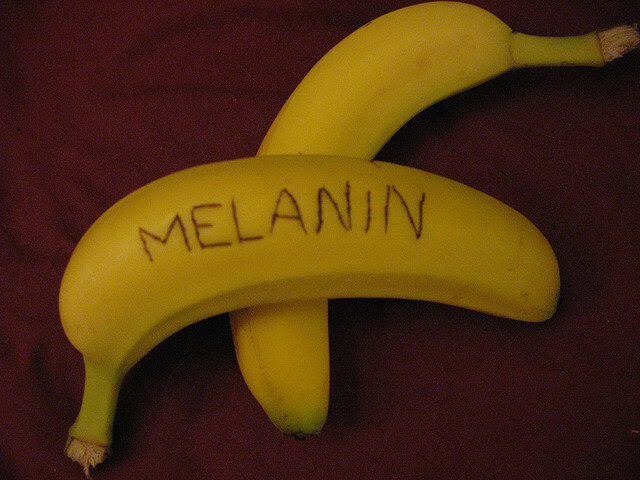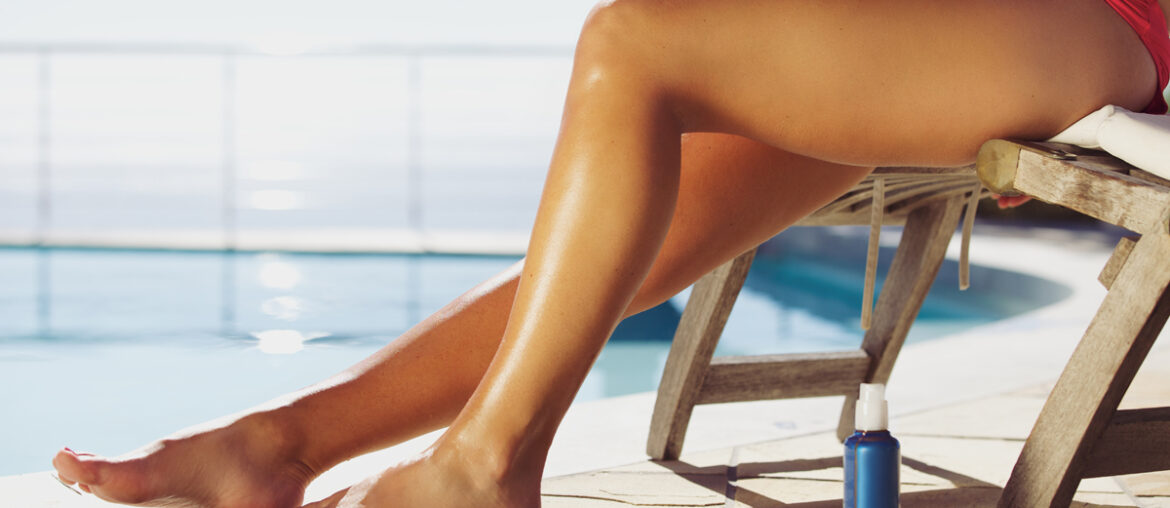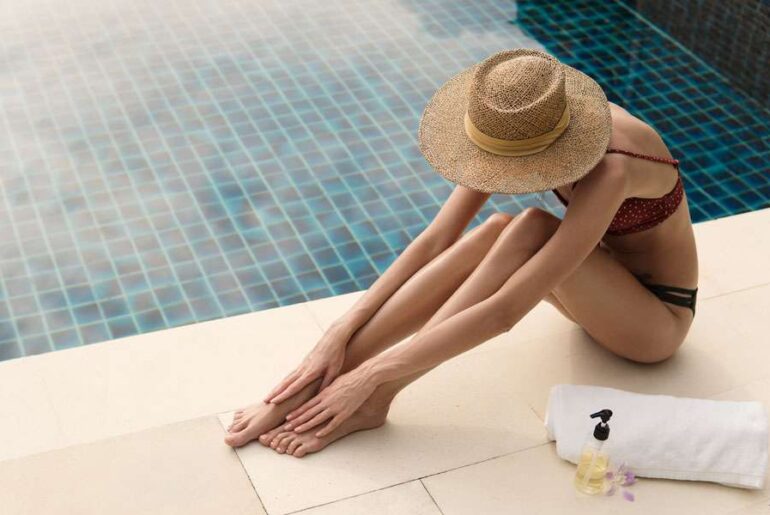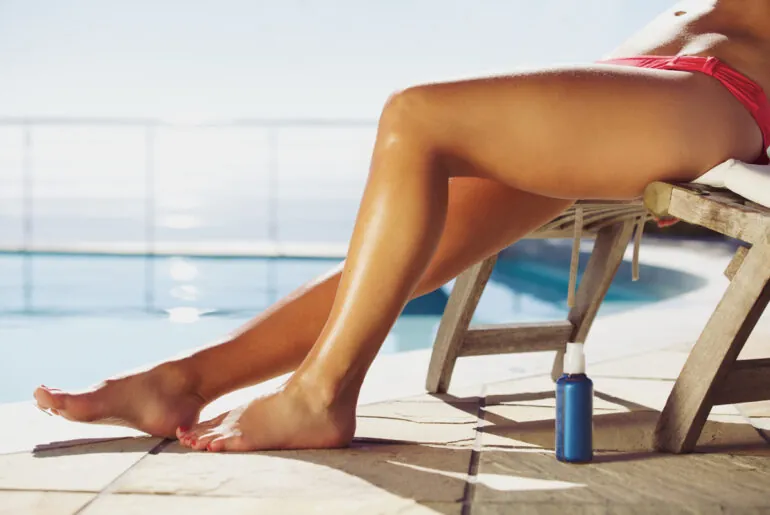Knowing how tanning works and how the skin becomes tanned can influence the way many people darken their skin. Many people have little or no understanding of the tanning process and repeatedly make incorrect choices when trying to gain a golden tan. Melanin in the skin plays a huge role in the tanning process, and it is crucial to understand the full scope of this process to make correct decisions.
To fully understand melanin, you must realize UV (Ultraviolet) rays and the effects of overexposure to the sun’s rays. Knowledge of these facts can help you keep your skin healthy while maintaining a beautiful tan.
What Is Melanin?

Melanin is a substance that is naturally produced by the body giving eyes, skin, hair, etc., its color. People with a darker skin complexion have higher amounts of melanin in their bodies, whereas people with a lower amount of melanin have fair skin and hair.
Melanin can provide many great benefits. The most recognized one is about contact with the sunlight. The body produces melanin as natural protection against the sun’s harmful ultraviolet rays, but it doesn’t provide complete and total protection. It is widely believed that people with dark skin and a high presence of melanin don’t have to be wary of the sun’s rays. But they are as much at risk as people with light skin.
People with a higher melanin content can indeed tolerate the sun for longer, but they are still able to become sunburned. Melanin is essential in gaining a tan as it is this pigment that reacts with ultraviolet rays to produce a darker skin tone.
UV Rays
The first stage of the tanning process occurs when exposed skin is in contact with ultraviolet rays from the sun. There are two types of rays called UVA and UVB rays. UVA rays do not go deep into the skin and consist of a much longer wavelength than UVB rays which dive right into the depths of the skin. These UVB rays, once deep in the skin, begin a process leading to the production of melanin.
There are hundreds of different types of tanning beds available these days, and most use different types of tanning lamps, all producing different results and causing various problems. Every tanning lamp produces different levels of ultraviolet rays and has different strength settings producing weaker or stronger tanning. The tanning lamps, which produce a much higher output of ultraviolet rays, provide the skin with a much healthier chance of claiming a nice golden tan without a high probability of sunburn.
The process is seen when the melanin is released by the skin and produces darker skin color. Once the melanin has been released, it becomes unnecessary to continue trying to capture the ultraviolet rays as the tanning process is already in action. The UVB rays in great numbers can lead to a higher risk of sunburn than a nice tan.
The Role of Melanin
Essentially melanin is a naturally occurring pigment and is the body’s first line of defense against receiving a sunburn. When the ultraviolet rays from the sun or tanning lamp come into contact with the exposed skin, a reaction takes place inside your body where melanocytes work to produce melanin into the skin.
It takes place because melanin can help protect your skin from contacting too much ultraviolet light, which can cause harm and sunburn. The melanin works by reacting with the ultraviolet rays that are still contacting the exposed skin. This reaction takes place on the surface of your skin, and as the ultraviolet rays come into contact with the melanin, the melanin reacts with the rays causing it to turn a darker shade and producing what is known as a tan.
The melanin works very hard to stop overexposure to ultraviolet rays. Still, the body is only capable of creating a limited amount of melanin, and sunburn can be caused once the melanin has all been absorbed. The ultraviolet rays that continue to contact your skin after the melanin has run out will instead become absorbed by skin cells and lead to skin problems.
If the body didn’t produce melanin, it would be helpless in protecting itself against the ultraviolet rays the skin comes in contact with. Melanin is essential to protect our bodies and prevent the sun or other ultraviolet light sources from causing sunburn and skin disease.
Melanin Reproduction Rate
The melanin produced by your body has a limit; it is essential to know this limit to prevent sunburn. Once the melanin has been used to protect against the ultraviolet rays, the body will immediately start to try and produce more to continue protecting itself. The reproduction of melanin isn’t instant and can take up to two full days before it is complete and ready to face the ultraviolet rays again.
It is strongly advised not to try and gain a tan while the melanin is reproducing as this can be very dangerous and lead to severe skin conditions. If you decided to gain a tan one day and then the next day went out in the warm sun to try and gain a darker tan, the melanin will only have had a chance to replenish itself by fifty percent, meaning you will not gain complete protection from the sun or turn a darker color as melanin is what causes the skin to darken. Trying to tan too often is a recipe for disaster.
The most advisable and healthy way to gain a great tan is to allow time for the body to fully replenish the melanin before exposing yourself to another batch of ultraviolet rays. As you age, the skin slowly loses its ability to tan, especially after too much tanning. Tanning too much could lead to the body becoming unable to produce necessary levels of melanin and could lead to a disastrous loop.
Constantly tanning and not allowing the melanin to fully reproduce could be causing long-term damage to your body. It is a nasty habit that many people suffer from, and by not allowing their melanin levels to replenish to one hundred percent, people could expose themselves to a range of skin diseases.
Many people believe that their melanin doesn’t need to be fully replenished before taking to tanning again, but this can lead to the body considering that the melanin levels are already at one hundred percent and only producing fifty to sixty percent of the melanin levels consistently, even with the correct period left between tannings.
Melanin As A Natural Sunscreen
Many people present a case that melanin can be relied upon instead of sunscreen bought from the shops to produce a tan. It is certainly possible to do so, but you must be wise if doing so. So many people use sunscreen to enjoy prolonged periods in the sun without the need to worry about melanin levels or getting sunburn.
The ultraviolet UVB rays are known to contain a great source of Vitamin D. By not using sunscreen and allowing the rays to react with the melanin produced by your body. You can increase your intake of this vital vitamin.
There are ways to try and improve the natural production of melanin by using chemicals such as Tyrosine and Psoralen. Tyrosine is an amino acid that is used by the body in the production of melanin. It is present in many products in the shops, and applying it to your skin may help the body’s natural production of melanin. Psoralen, on the other hand, makes the skin more sensitive to the ultraviolet rays produced by the sun but is dangerous to use to gain a darker tan.
The best way to help your body produce melanin is to tan regularly and steadily. The trick is not to overdo the tanning but tan every few days, giving the melanin time to replenish and tan again. By doing this, you will build up a healthy level of melanin in your body and be protected from the sun’s ultraviolet rays while maintaining a beautiful and healthy tan. You can use tanning beds to keep up the tanning routine as long as you don’t overuse them.
Enjoying a tan can help a person’s self-confidence and boost them, so tanning shouldn’t be all about worrying if you are producing enough melanin or if you might get burnt. By being sensible with your tanning, you will maintain healthy skin and good levels of melanin.
Melanin And Tanning Beds
It is generally agreed that tanning beds are safer than exposing yourself to the sun’s ultraviolet rays. Tanning lamps emit a significantly less amount of harmful rays than exposure to the sun does. The power to control the volume of ultraviolet rays and the time you are exposing yourself to them can make tanning beds a very safe way to get a tan as long as they are used responsibly.
Regularly using a tanning bed can be an excellent solution for your body to receive the necessary Vitamin D quantitates it needs. Some people have even claimed that receiving ultraviolet rays in your skin is the only way to gain your daily Vitamin D needs. That is slightly untrue; however, tanning beds are an excellent way to get Vitamin D.
Although these claims put tanning beds in a great light, you should also be aware of the danger of using them and take caution. The ultraviolet rays produced by the manufactured lamps in tanning salons can penetrate the skin very deeply as they are concentrated on one spot for a prolonged time. It can lead to long-term effects such as leathery skin or premature wrinkles.
Another harmful side effect of the incorrect use of tanning salons is when people use them too often, the melanin in their body ceases to reproduce quickly enough leading to the potential for burning or tissue damage. Ultimately this can all lead to cancer.
Top Tips To Protect Melanin When Tanning
- Rotate your body often when lying in the sun to ensure you get an even tan on the front and back, and neither is exposed for a prolonged period.
- If you regularly tan in ultraviolet rays, see your doctor at least once a year to ensure there are no underlying skin problems.
- Dehydrated skin burns much easier than hydrated skin, so keep drinking water and always have some close to hand.
- When you are higher up, in the mountains or a city high above sea level, you are at more risk of getting burned and should wear protective clothing. The same is true if you are close to the equator.
- Ultraviolet rays are not only omitted from the sun during the summer months; even in winter, you are still at risk of reducing your melanin count if you are not responsible.
- When you are in the water, the ultraviolet rays are reflected onto your body so remember to reapply sun cream after going for a swim.
- The sun is at its hottest during the day between 11 am and 2 pm, so if you are tanning during this time, bear in mind that your melanin is working overtime.
- If you don’t like the idea of using a tanning bed or lying in the sun all day, there are plenty of self-tan lotions and sprays available in the stores to offer an excellent tan without any exposure.
- Remember that you can gain Vitamin D from sources other than the sun’s ultraviolet rays, so don’t solely depend on the sun for your intake.
Always be safe and remember that melanin is irreplaceable once lost.






